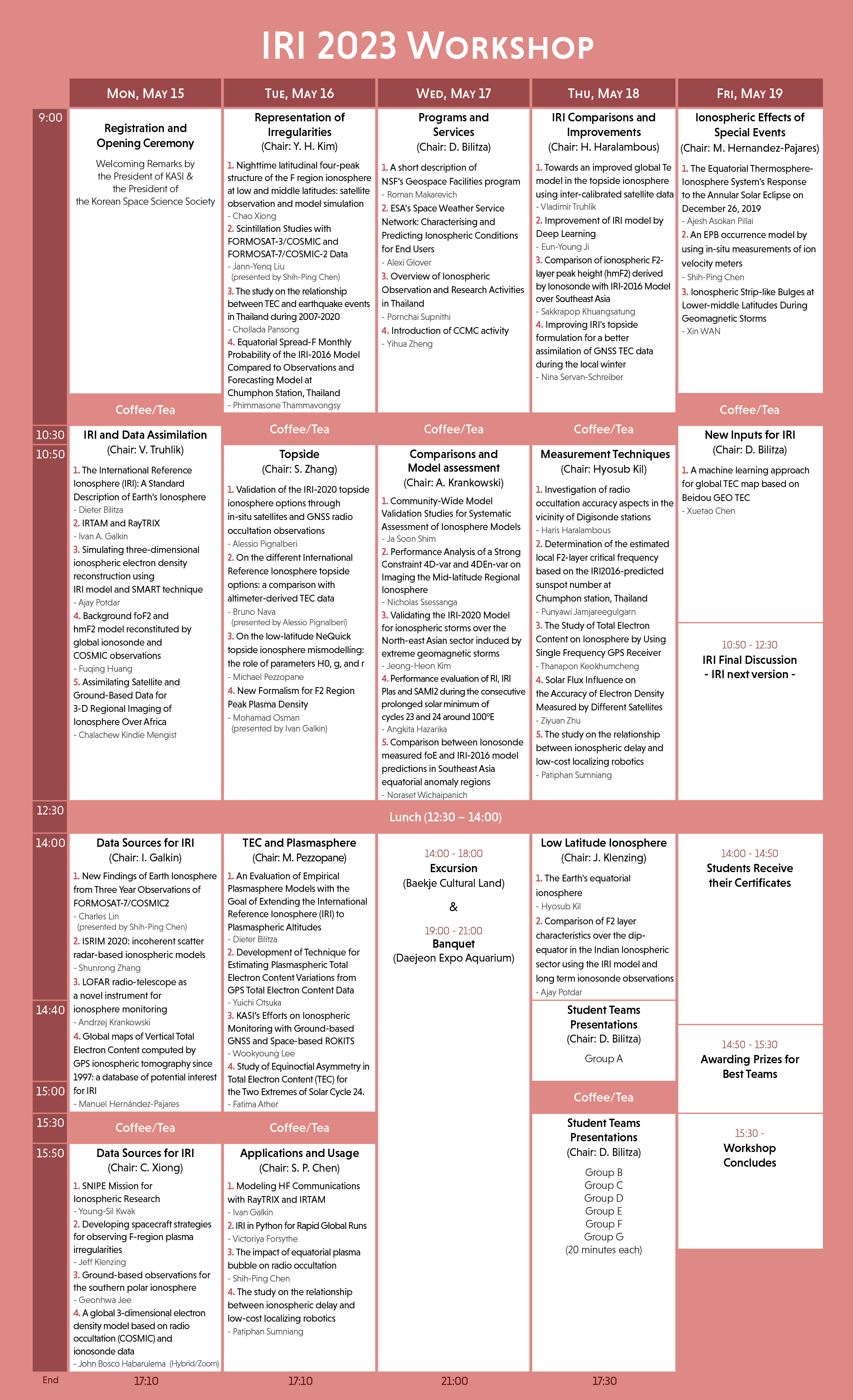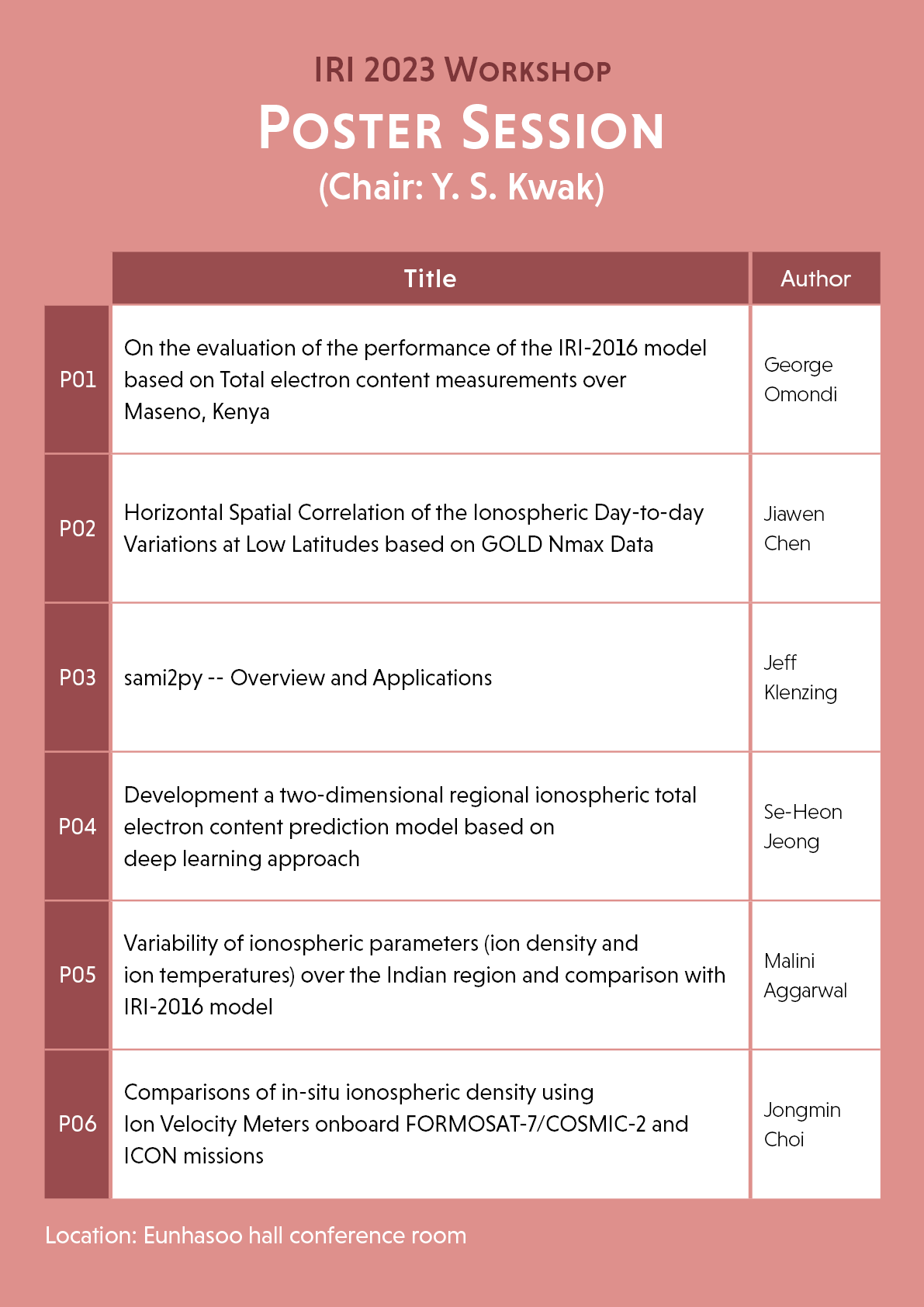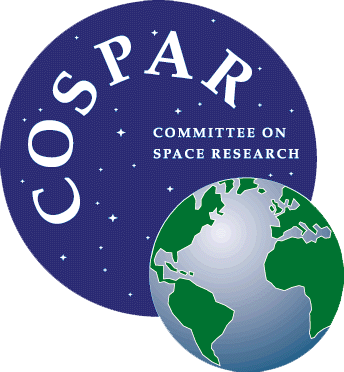IRI workshop Program
Programs


| Monday, May 15 | Eunhasoo hall 1F conference room | |
|---|---|---|
| 09:00 – 10:00 | Registration and Opening Ceremony | |
| 10:00 – 10:30 | Coffee/Tea | |
| 10:30 - 12:10 | IRI and Data Assimilation | Chair: V. Truhlik |
| 10:30 - 11:00 | The International Reference Ionosphere (IRI): A Standard Description of Earth’s Ionosphere | Dieter Bilitza |
| 10:50 – 11:10 | IRTAM and RayTRIX | Ivan A. Galkin |
| 11:10 – 11:30 | Simulating three-dimensional ionospheric electron density reconstruction using IRI model and SMART technique | Ajay Potdar |
| 11:30 – 11:50 | Background foF2 and hmF2 model reconstituted by global ionosonde and COSMIC observations | Fuqing Huang |
| 11:50 – 12:10 | Assimilating Satellite and Ground-Based Data for 3-D Regional Imaging of Ionosphere Over Africa | Chalachew Kindie Mengist |
| 12:30 – 14:00 | Lunch | |
| 14:00 - 15:20 | Data Sources for IRI | Chair: I. Galkin |
| 14:00 – 14:20 | New Findings of Earth Ionosphere from Three Year Observations of FORMOSAT-7/COSMIC2 | Charles Lin (presented by Shih-Ping Chen) |
| 14:20 – 14:40 | ISRIM 2020: incoherent scatter radar-based ionospheric models | Shunrong Zhang |
| 14:40 – 15:00 | LOFAR radio-telescope as a novel instrument for ionosphere monitoring | Andrzej Krankowski |
| 15:00 – 15:20 | Global maps of Vertical Total Electron Content computed by GPS ionospheric tomography since 1997: a database of potential interest for IRI | Manuel Hernández-Pajares |
| 15:20 – 15:50 | Coffee/Tea | |
| 15:50 - 17:10 | Data Sources for IRI | Chair: C. Xiong |
| 15:50 – 16:10 | SNIPE Mission for Ionospheric Research | Young-Sil Kwak |
| 16:10 – 16:30 | Developing spacecraft strategies for observing F-region plasma irregularities | Jeff Klenzing |
| 16:30 – 16:50 | Ground-based observations for the southern polar ionosphere | Geonhwa Jee |
| 16:50 – 17:10 | A global 3-dimensional electron density model based on radio occultation (COSMIC) and ionosonde data | John Bosco Habarulema (Hybrid/Zoom) |
| Tuesday, May 16 | Eunhasoo hall 1F conference room | |
|---|---|---|
| 09:00 - 10:20 | Representation of Irregularities | Chair: Y. H. Kim |
| 09:00 – 09:20 | Nighttime latitudinal four-peak structure of the F region ionosphere at low and middle latitudes: satellite observation and model simulation | Chao Xiong |
| 09:20 – 09:40 | Scintillation Studies with FORMOSAT-3/COSMIC and FORMOSAT-7/COSMIC-2 Data | Jann-Yenq Liu (presented by Shih-Ping Chen) |
| 09:40 – 10:00 | The study on the relationship between TEC and earthquake events in Thailand during 2007-2020 | Chollada Pansong |
| 10:00 – 10:20 | Equatorial Spread-F Monthly Probability of the IRI-2016 Model Compared to Observations and Forecasting Model at Chumphon Station, Thailand | Phimmasone Thammavongsy |
| 10:20 - 10:50 | Coffee/Tea | |
| 10:50 - 12:10 | Topside | Chair: S. Zhang |
| 10:50 – 11:10 | Validation of the IRI-2020 topside ionosphere options through in-situ satellites and GNSS radio occultation observations | Alessio Pignalberi |
| 11:10 – 11:30 | On the different International Reference Ionosphere topside options: a comparison with altimeter-derived TEC data | Bruno Nava (presented by Alessio Pignalberi) |
| 11:30 – 11:50 | On the low-latitude NeQuick topside ionosphere mismodelling: the role of parameters H0, g, and r | Michael Pezzopane |
| 11:50 – 12:10 | New Formalism for F2 Region Peak Plasma Density | Mohamad Osman (presented by Ivan Galkin) |
| 12:30 - 14:00 | Lunch | |
| 14:00 - 15:20 | TEC and Plasmasphere | Chair: M. Pezzopane |
| 14:00 – 14:20 | An Evaluation of Empirical Plasmasphere Models with the Goal of Extending the International Reference Ionosphere (IRI) to Plasmaspheric Altitudes | Dieter Bilitza |
| 14:20 – 14:40 | Development of Technique for Estimating Plasmaspheric Total Electron Content Variations from GPS Total Electron Content Data | Yuichi Otsuka |
| 14:40 – 15:00 | KASI’s Efforts on Ionospheric Monitoring with Ground-based GNSS and Space-based ROKITS | Wookyoung Lee |
| 15:00 – 15:20 | Study of Equinoctial Asymmetry in Total Electron Content (TEC) for the Two Extremes of Solar Cycle 24. | Fatima Ather |
| 15:20 - 15:50 | Coffee/Tea | |
| 15:50 - 17:10 | Applications and Usage | Chair: S. P. Chen |
| 15:50 – 16:10 | Modeling HF Communications with RayTRIX and IRTAM | Ivan Galkin |
| 16:10 – 16:30 | IRI in Python for Rapid Global Runs | Victoriya Forsythe |
| 16:30 – 16:50 | The impact of equatorial plasma bubble on radio occultation | Shih-Ping Chen |
| 16:50 – 17:10 | The study on the relationship between ionospheric delay and low-cost localizing robotics | Patiphan Sumniang |
| Wednesday, May 17 | Eunhasoo hall 1F conference room | |
|---|---|---|
| 09:00 - 10:20 | Programs and Services | Chair: D. Bilitza |
| 09:00 – 09:20 | A short description of NSF’s Geospace Facilities program | Roman Makarevich |
| 09:20 – 09:40 | ESA’s Space Weather Service Network: Characterising and Predicting Ionospheric Conditions for End Users | Alexi Glover |
| 09:40 – 10:00 | Overview of Ionospheric Observation and Research Activities in Thailand | Pornchai Supnithi |
| 10:00 – 10:20 | Introduction of CCMC activity | Yihua Zheng |
| 10:20 - 10:50 | Coffee/Tea | |
| 10:50 - 12:10 | Comparisons and Model assessment | Chair: A. Krankowski |
| 10:50 – 11:10 | Community-Wide Model Validation Studies for Systematic Assessment of Ionosphere Models | Ja Soon Shim |
| 11:10 – 11:30 | Performance Analysis of a Strong Constraint 4D-var and 4DEn-var on Imaging the Mid-latitude Regional Ionosphere | Nicholas Ssessanga |
| 11:30 – 11:50 | Validating the IRI-2020 Model for ionospheric storms over the North-east Asian sector induced by extreme geomagnetic storms. | Jeong-Heon Kim |
| 11:50 – 12:10 | Performance evaluation of IRI, IRI Plas and SAMI2 during the consecutive prolonged solar minimum of cycles 23 and 24 around 100°E | Angkita Hazarika |
| 12:10 – 12:30 | Comparison between Ionosonde measured foE and IRI-2016 model predictions in Southeast Asia equatorial anomaly regions | Noraset Wichaipanich |
| 12:30 - 14:00 | Lunch | |
| 14:00 - 18:00 | Excursion (Baekje Cultural Land) | |
| 19:00 - 21:00 | Banquet (Daejeon Expo Aquarium) |
| Thursday, May 18 | Eunhasoo hall 1F conference room | |
|---|---|---|
| 09:00 - 10:20 | IRI Comparisons and Improvements | Chair: H. Haralambous |
| 09:00 – 09:20 | Towards an improved global Te model in the topside ionosphere using inter-calibrated satellite data | Vladimir Truhlik |
| 09:20 – 09:40 | Improvement of IRI model by Deep Learning | Eun-Young Ji |
| 09:40 – 10:00 | Comparison of ionospheric F2-layer peak height (hmF2) derived by Ionosonde with IRI-2016 Model over Southeast Asia | Sakkrapop Khuangsatung |
| 10:00 – 10:20 | Improving IRI's topside formulation for a better assimilation of GNSS TEC data during the local winter | Nina Servan-Schreiber |
| 10:20 - 10:50 | Coffee/Tea | |
| 10:50 - 12:10 | Measurement Techniques | Chair: Hyosub Kil |
| 10:50 – 11:10 | Investigation of radio occultation accuracy aspects in the vicinity of Digisonde stations | Haris Haralambous |
| 11:10 – 11:30 | Determination of the estimated local F2-layer critical frequency based on the IRI2016-predicted sunspot number at Chumphon station, Thailand | Punyawi Jamjareegulgarn |
| 11:30 – 11:50 | The Study of Total Electron Content on Ionosphere by Using Single Frequency GPS Receiver | Thanapon Keokhumcheng |
| 11:50 – 12:10 | Solar Flux Influence on the Accuracy of Electron Density Measured by Different Satellites | Ziyuan Zhu |
| 12:10 – 12:30 | The study on the relationship between ionospheric delay and low-cost localizing robotics | Patiphan Sumniang |
| 12:30 - 14:00 | Lunch | |
| 14:00 - 14:40 | Low Latitude Ionosphere | Chair: J. Klenzing |
| 14:00 – 14:20 | The Earth's equatorial ionosphere | Hyosub Kil |
| 14:20 – 14:40 | Comparison of F2 layer characteristics over the dip-equator in the Indian Ionospheric sector using the IRI model and long term ionosonde observations | Ajay Potdar |
| 14:40 - 17:30 | Student Teams Presentations | Chair: D. Bilitza |
| 14:40 – 15:00 | Group A | |
| 15:00 - 15:30 | Coffee/Tea | |
| 15:30 – 15:50 | Group B | |
| 15:50 – 16:10 | Group C | |
| 16:10 – 16:30 | Group D | |
| 16:30 – 16:50 | Group E | |
| 16:50 – 17:10 | Group F | |
| 17:10 – 17:30 | Group G |
| Friday, May 19 | Eunhasoo hall 1F conference room | |
|---|---|---|
| 09:00 - 10:20 | Ionospheric Effects of Special Events | Chair: M. Hernandez-Pajares |
| 09:00 - 09:20 | The Equatorial Thermosphere-Ionosphere System's Response to the Annular Solar Eclipse on December 26, 2019 | Ajesh Asokan Pillai |
| 09:20 - 09:40 | An EPB occurrence model by using in-situ measurements of ion velocity meters | Shih-Ping Chen |
| 09:40 – 10:00 | Ionospheric Strip-like Bulges at Lower-middle Latitudes During Geomagnetic Storms | Xin WAN |
| 10:00 - 10:30 | Coffee/Tea | |
| 10:30 – 10:50 | New Inputs for IRI | Chair: D. Bilitza |
| 10:30 – 10:50 | A machine learning approach for global TEC map based on Beidou GEO TEC | Xuetao Chen |
| 10:50 – 12:30 | IRI FINAL DISCUSSION – IRI next version | |
| 12:30 - 14:00 | Lunch | |
| 14:00 – 14:50 | Students Receive their Certificates | |
| 14:50 – 15:30 | Awarding Prizes for Best Teams | |
| 15:30 – | Workshop concludes |
Poster Session
| Chair: Y. S. Kwak | Eunhasoo hall 1F conference room | |
|---|---|---|
| P01 | On the evaluation of the performance of the IRI-2016 model based on Total electron content measurements over Maseno, Kenya | George Omondi |
| P02 | Horizontal Spatial Correlation of the Ionospheric Day-to-day Variations at Low Latitudes based on GOLD Nmax Data | Jiawen Chen |
| P03 | sami2py -- Overview and Applications | Jeff Klenzing |
| P04 | Development a two-dimensional regional ionospheric total electron content prediction model based on deep learning approach | Se-Heon Jeong |
| P05 | Variability of ionospheric parameters (ion density and ion temperatures) over the Indian region and comparison with IRI-2016 model | Malini Aggarwal |
| P06 | Comparisons of in-situ ionospheric density using Ion Velocity Meters onboard FORMOSAT-7/COSMIC-2 and ICON missions | Jongmin Choi |
Venue: conference hall in Eunhasoo Hall
- ※ Fast Internet (Wi-Fi for laptops in the lecture room) will be available at the workshop venue.
